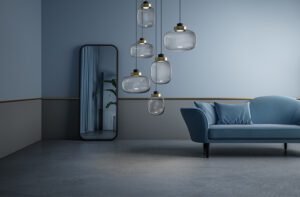Q and A with Landscape Architect Matthew Cunningham
June 3, 2014
By Paula M. Bodah
If you enjoy gardening you’ve likely been hard at work the past couple of weekends, getting the tomatoes in the ground, filling the flower boxes, and planting this year’s bounty of colorful annuals. While amateurs like us squeeze in our planting, mulching, and weeding in our off hours, there’s no such thing as downtime for the pros. Matthew Cunningham—a 2013 winner of New England Home’s 5 Under 40 awards and a busy Winchester, Massachusetts-based landscape architect—took a few minutes out of his springtime whirlwind schedule to talk about what makes a good garden great.

One of Matthew’s recent projects, “Longwood Garden,” received a 2014 Merit Award from the Boston Society of Landscape Architects and a 2014 Suburbia Transformed Award from the James Rose Center in New Jersey.
Photograph courtesy of Matthew Cunningham Landscape Design
What does your own landscape look like?
My own garden is a personal laboratory. I wouldn’t say that it is always the tidiest or prettiest property in the neighborhood, but for me, it is a place to tinker and dabble with ideas. I don’t have an irrigation system, intentionally, so I can personally attest to my clients whether something is durable and or hardy.
Is there a particular trend or element you find your clients asking for lately?
Many of our clients have been requesting veggie and herb gardens, or some other edible component to their landscapes. We plant lots of low- and high-bush blueberry because it not only offers delicious fruit, but it presents a great display of spring flowers and incredible fall foliage. There also seems to be a solid desire and commitment from many of our clients for design projects that focus on kid and pet-friendly outdoor spaces. We’ve done many sports courts recently, and we’ve also designed several lawn areas that are sized to allow for bocce, soccer, volleyball, and even seasonal ice skating rinks!
Is the current emphasis on using native plants more than a trend? Why is it important (or not)?
Native plants are truly the foundation of our office’s work, and it is not a trend. As global climate change becomes more and more real, landscape architects are being forced to specify durable plant materials that can withstand radical changes in temperature and moisture year-round. Natives are naturally much more disease- and pest-resistant than a lot of the hybrids you find in typical suburban gardens. In the big picture, it just makes sense to use plant materials that can flourish without the use of chemicals (herbicides and pesticides) to keep them looking great.
How about the current enthusiasm for plants that attract bees, birds, or butterflies? Do you find clients are looking for that?
We do everything we can to design and construct our gardens as living ecosystems, rather than sterile landscapes filled vast areas of orange mulch and ubiquitous plantings that could be found in your neighborhood big-box parking lot. Fundamentally, we need those birds, bees, and butterflies to survive. Without them, we die; it’s blunt to say that, but it’s the harsh truth. I understand why some of our clients are a little squeamish about various creepy crawlies, but designing pocket habitats that support beneficial insects into a landscape can only help us all in the long run!
Do those sprays that repel rabbit and deer actually work? Does anything really work?
There are indeed a number of proprietary sprays and granular repellants that work pretty well. We’ve had luck with everything from cayenne pepper sprays to pure coyote urine—yes, seriously, coyote urine. I think the trick is to alternate between different types of repellants so that the animals you are trying to prevent from visiting your garden don’t get used to certain scents. Of course, you could always use plants that are less appealing, but then again, what is a garden without a peony?
How does the architecture of a house influence the way you design the landscape?
Everything about the house influences the way we design our landscapes. Our gardens grow directly from the geometry and materiality of our client’s homes. About 50 percent of our projects begin with existing houses, which means you have to make something make sense with the interior floor plan. There’s just nothing like starting from scratch with a fully integrated design team in place that includes an architect, landscape architect, interior designer, builder, etc. From the start of our projects, our goal is understand how our clients will use their properties, and we work hard to integrate their indoor and outdoor lifestyles.
Are there any new trends or products for hardscaping that you especially like?
We have been integrating reclaimed materials into our hardscapes for about ten years. I grew up in a rural atmosphere in coastal Maine, and was constantly educated in the ways of “waste not, want not.” I’m especially drawn to weathered stones because their patina adds an instant sense of history and sense of place to a garden. I find that most of our clients like this approach as well because it makes a garden feel instantly contextual.
What is the one aspect of landscape design that you have to work hardest to educate clients about?
Simply put, there is no such thing as a “no maintenance” landscape. A low-maintenance approach is realistic, but given that the majority of our work is in urban or suburban context, the realities of dense urban living come to life quickly. From rampant squirrel, rabbit, and turkey populations digging up freshly planted beds, to a sudden infusion of invasive plant species such as pokeberry, Japanese knotweed, or garlic-mustard weed into your garden, you’ll always have maintenance. The trick is to work with nature… not against it.
Share
![NEH-Logo_Black[1] NEH-Logo_Black[1]](https://b2915716.smushcdn.com/2915716/wp-content/uploads/2022/08/NEH-Logo_Black1-300x162.jpg?lossy=1&strip=1&webp=1)






